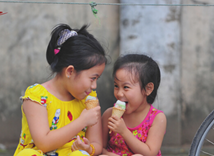Munhwaŏ, or North Korean, is the official language of the Democratic People's Republic of Korea (DPRK). It is also the official language of the Yanbian region of China and several neighboring Chinese regions.

Recognized as a standard language in 1966, “munhwaŏ” is similar to Mongolian and Manchu (*), with a sentence structure similar to that of Japanese.
As for its script, it comprises 14 consonants and 10 vowels, making a 24-letter alphabet.
Finally, unlike South Korean, which borrows many words of American origin, North Korean has retained its authenticity and the purity of the language. North Korea has a more conservative approach, with a tendency to reinforce the use of words of Korean origin. These differences can pose challenges to understanding between speakers of the two countries, although communication generally remains fluid.
Here are a few words that differ between North and South Korean:
- Television: South: telebi (텔레비전) / North: jeonpaggi (전파기)
- Corn: South: oksusu (옥수수) / North: kangnaengi (강냉이)
- Cuttlefish: South: ojingeo (오징어) / North: muneojolim (문어조림)
Note:
(*) Manchu: A language belonging to the Tungus language family, spoken by the Manchu people, who live mainly in China, particularly in Manchuria. Historically, the Manchus founded the Qing dynasty, which ruled China from 1644 to 1912. Manchu went into decline in the 20th century, largely due to Chinese cultural domination. Today, the language is considered endangered, with very few native speakers remaining.








